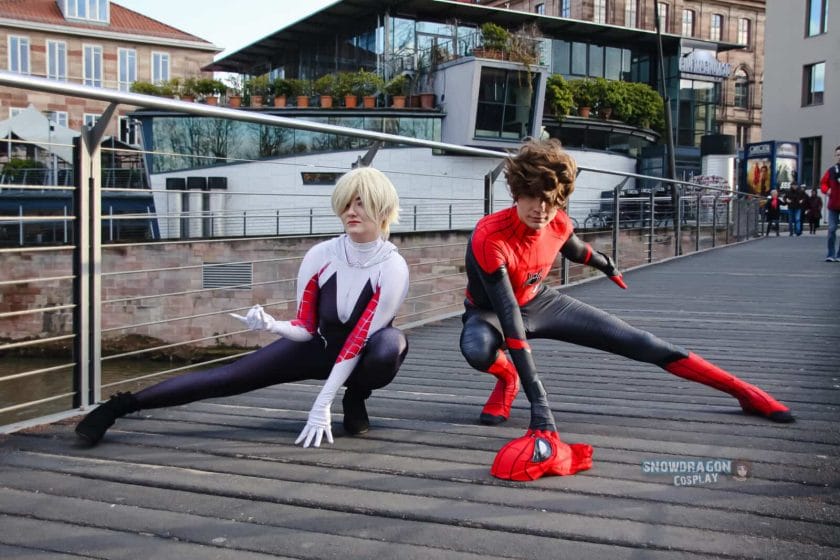Author
-

German Cosplayer from Nürnberg, professional Model & Walkingact for events & content creator.
https://images-wixmp-ed30a86b8c4ca887773594c2.wixmp.com/f/090e3742-be6d-485f-861f-344d5ba9f907/d113f1v-5bdd8a24-fddd-49ea-aa62-d2baabe30a31.jpg?token=eyJ0eXAiOiJKV1QiLCJhbGciOiJIUzI1NiJ9.eyJzdWIiOiJ1cm46YXBwOjdlMGQxODg5ODIyNjQzNzNhNWYwZDQxNWVhMGQyNmUwIiwiaXNzIjoidXJuOmFwcDo3ZTBkMTg4OTgyMjY0MzczYTVmMGQ0MTVlYTBkMjZlMCIsIm9iaiI6W1t7InBhdGgiOiJcL2ZcLzA5MGUzNzQyLWJlNmQtNDg1Zi04NjFmLTM0NGQ1YmE5ZjkwN1wvZDExM2Yxdi01YmRkOGEyNC1mZGRkLTQ5ZWEtYWE2Mi1kMmJhYWJlMzBhMzEuanBnIn1dXSwiYXVkIjpbInVybjpzZXJ2aWNlOmZpbGUuZG93bmxvYWQiXX0.lfN8OdaGSzV_kQLEZKHzZm-KijDEENuG8eIpsAgWbzo
1. Materials commonly used to make cosplay wings that move
When it comes to creating cosplay wings that move, there are a variety of materials you can use to bring your designs to life. Here are some common materials that cosplayers often use:
- Foam: Foam is a versatile material that can be easily shaped and carved into wing shapes. It is lightweight and can be painted or covered with fabric for added texture.
- Wire: Wire is used as a framework for the wings, providing structure and support. It can be bent and shaped into various wing shapes.
- Mechanical components: To create movement in the wings, cosplayers often incorporate mechanical components such as servos, gears, and motors. These components allow the wings to flap or open and close.
- Fabric: Fabric is used to cover the wings and add visual interest. It can be dyed or painted to achieve desired colors or patterns.
- Feathers: For a more realistic look, feathers can be attached to the foam or wire framework of the wings. They can be sourced from craft stores or online suppliers.
These materials can be combined in various ways depending on your design vision and budget. Don’t be afraid to experiment with different materials to achieve the desired effect!
A Personal Story:
Once upon a time at Nekodanshi, our team decided to create a set of cosplay wings that would not only look stunning but also have mesmerizing movement. We brainstormed ideas while sipping on our favorite bubble tea flavors (a must-have for any creative session).
We knew we wanted the wings to have an ethereal quality, so we opted for foam as our main material. Foam is lightweight, easy to work with, and allows for intricate details. Plus, it’s perfect for adding LED lights later on (but more on that in another subheading).
To give the wings structure and movement, we decided to use a combination of wire and mechanical components. Our resident engineer, Hiroshi, suggested using servos and gears to create a flapping motion. We were all excited about the idea of bringing our characters to life with realistic wing movements.
Of course, no cosplay wings are complete without some fabulous feathers! We sourced a variety of feathers from our local craft store and spent hours meticulously attaching them to the foam framework. It was like giving our wings their own unique personalities.
With our materials chosen and our vision set, we were ready to embark on the journey of creating moving cosplay wings that would turn heads at conventions. Little did we know the challenges and triumphs that awaited us along the way…
2. Creating a basic framework for your cosplay wings
Materials needed:
- Wire or PVC pipes
- Foam or cardboard
- Hot glue gun
- Scissors
- Measuring tape
Step 1: Planning and Designing
Before starting the construction of your cosplay wings, it is essential to plan and design the shape and size you desire. Consider the character you are cosplaying as well as any specific requirements for movement mechanisms. Sketch out your ideas and measurements on paper before moving forward.
Step 2: Building the Frame
Using wire or PVC pipes, create a basic frame that will serve as the structure for your wings. Bend and shape the wire or connect the PVC pipes using fittings to achieve the desired wing shape. Make sure to leave enough space for adding movement mechanisms later.
Step 3: Adding Support and Stability
To ensure that your wings are sturdy and can withstand movement, reinforce the frame with foam or cardboard. Cut pieces of foam or cardboard to fit around the frame, attaching them securely with hot glue. This will provide stability and prevent any wobbling or bending during use.
Step 4: Finalizing the Shape
Once the support materials are in place, trim away any excess foam or cardboard to refine the shape of your wings. Use scissors to carefully cut along the edges, creating smooth lines and curves. Take measurements again at this stage to ensure accuracy.
Creating a solid framework is crucial for building moving cosplay wings that are both durable and functional. With careful planning, designing, and construction, you can lay a strong foundation for adding movement mechanisms in the next steps.
3. Tools and equipment needed for making moving cosplay wings
Essential tools:
- Wire cutters
- Pliers
- Screwdriver set
- Drill (with various drill bits)
- Sewing machine (optional, depending on design)
Wire Cutters:
Wire cutters are essential for cutting through wire or other materials used in the construction of your wings. They allow for precise cuts and help ensure that your wings are built to the desired specifications.
Pliers:
Pliers come in handy when working with small parts, such as attaching screws or manipulating wires. They provide a firm grip and allow for controlled movements during assembly.
Screwdriver Set:
A set of screwdrivers with different sizes and types of heads is necessary for attaching movement mechanisms to your cosplay wings. Whether it’s tightening screws or assembling gears, having the right screwdriver will make the process much easier.
Drill:
If you plan to use more advanced movement mechanisms like servos or motors, a drill is essential for creating holes to mount these components securely. Different drill bits can be used depending on the size and type of holes required.
Sewing Machine:
Depending on your wing design, a sewing machine may be necessary for attaching fabric or other materials to the framework. This tool allows for precise stitching and ensures that everything is securely fastened together.
Having these essential tools at hand will greatly facilitate the construction process of your moving cosplay wings. Additionally, it is always recommended to have safety equipment such as gloves and goggles when using power tools or working with sharp objects.
4. Techniques for adding movement mechanisms to the wings
Mechanical Methods
One technique for adding movement mechanisms to cosplay wings is by using mechanical methods. This can involve using gears, pulleys, or levers to create the desired wing movement. For example, gears can be used to connect the wings to a motor or crankshaft, allowing them to flap up and down. Pulleys can be used to create a sliding motion in the wings, while levers can be used to create a rotational movement.
Electrical Methods
Another technique for adding movement mechanisms is by using electrical methods. This can involve using motors or servos to control the wing movement. Motors can be connected directly to the wings, allowing them to move in various directions. Servos are commonly used in cosplay wings as they provide precise control over the movement and can be easily programmed.
List of tools needed:
– Gears
– Pulleys
– Levers
– Motors
– Servos
List of materials needed:
– Metal or plastic gears
– Cables or wires
– Crankshafts or axles
– Batteries or power supply
– Control board or microcontroller
Overall, there are various techniques that can be used to add movement mechanisms to cosplay wings, ranging from mechanical methods like gears and pulleys, to electrical methods like motors and servos.
5. Step-by-step instructions on attaching the movement mechanism to the wings
Attaching a movement mechanism to cosplay wings requires careful planning and execution. Here is a step-by-step guide on how to do it:
Step 1: Design and Plan
Start by designing your wing mechanism and determining where it will be attached on your wings. Consider factors such as weight distribution, balance, and range of motion. Create a detailed plan or blueprint to guide you throughout the process.
Step 2: Prepare the Wings
If your wings are not already assembled, construct them according to your design. Ensure they are sturdy enough to support the added movement mechanism. Sand and paint the wings if desired.
Step 3: Attach the Mechanism
Using screws, bolts, or adhesive, attach the movement mechanism to your wings as per your design. Make sure it is securely fastened and aligned properly for smooth movement.
Step 4: Connect the Control System
If using electrical methods, connect the control system such as motors or servos to the movement mechanism. This may involve soldering wires or using connectors as necessary. Test the connection to ensure proper functionality.
Step 5: Test and Adjust
Once everything is connected, test the movement of your wings. Make any necessary adjustments to ensure smooth and controlled motion. This may involve tweaking gear ratios, adjusting tension in cables or wires, or fine-tuning servo settings.
Remember to always prioritize safety when attaching a movement mechanism to cosplay wings and follow any manufacturer guidelines for using electrical components.
6. Safety considerations when making cosplay wings that move
When making cosplay wings that move, it is important to consider safety measures to ensure a safe and enjoyable experience. Here are some key safety considerations:
Choose Lightweight Materials
Opt for lightweight materials when constructing your wings to minimize strain on your body while wearing them. Heavy wings can cause discomfort and fatigue during long periods of wear.
Avoid Sharp Edges or Protrusions
Ensure that all edges and protrusions on your wing structure are rounded or padded to prevent injuries or accidents while moving around in crowded spaces. Smooth out any rough edges and cover sharp points.
Securely Fasten the Wings
Make sure your wings are securely fastened to your body or costume to prevent them from accidentally detaching or falling off during movement. Use strong straps, harnesses, or attachment methods that can withstand the stress of wing movement.
Consider Clearance and Mobility
Ensure that your wings do not hinder your mobility or pose a risk to others. Leave enough clearance around you to avoid accidentally hitting people or objects with your moving wings. Test the range of motion before wearing them in crowded spaces.
Use Reliable Electrical Components
If using electrical components for wing movement, choose reliable and safe components from reputable sources. Follow proper wiring practices, use appropriate voltage levels, and ensure all connections are secure to minimize the risk of electrical hazards.
By considering these safety measures, you can create cosplay wings that not only look impressive but also prioritize the well-being of yourself and those around you.
7. Ensuring smooth and controlled movement of the wings
Using lightweight materials
One important factor in ensuring smooth and controlled movement of cosplay wings is to use lightweight materials. Heavy materials can make the wings difficult to move and may strain the wearer’s back or shoulders. Consider using materials such as foam, lightweight plastics, or even wire frames to keep the wings light and easy to control.
Adding hinges or joints
To achieve smooth movement, incorporating hinges or joints into the design can be beneficial. These allow the wings to fold or extend with ease, giving them a more natural range of motion. Hinges can be made from various materials such as metal or plastic, depending on your preference and budget.
Example:
- Use lightweight EVA foam for the wing structure
- Add PVC pipe hinges for easy folding and extension
- Incorporate elastic straps for comfortable movement
8. Alternative methods for creating moving cosplay wings
Besides traditional mechanical methods, there are alternative ways to create moving cosplay wings that are worth exploring.
Using pneumatic systems
Pneumatic systems utilize compressed air to create movement in the wings. By connecting air pumps and valves to specific parts of the wing structure, you can achieve controlled flapping motions. This method requires additional knowledge of pneumatics but can result in impressive wing movements.
Incorporating animatronic mechanisms
If you want to take your cosplay wings to the next level, consider incorporating animatronic mechanisms. These mechanisms use motors and gears to create lifelike movements in various parts of the wing structure. While this method may require more advanced technical skills, it can result in incredibly realistic and dynamic wing motions.
9. Popular designs or styles of moving cosplay wings
There are several popular designs and styles of moving cosplay wings that cosplayers often choose to recreate.
Fairy wings
Fairy wings are a classic choice for many cosplayers. They often feature delicate, ethereal designs with fluttering movements. To achieve this effect, using lightweight materials and incorporating small hinges or joints can help create the illusion of fairy-like flight.
Demon or dragon wings
Demon or dragon wings are another popular choice among cosplayers. These wings tend to have a more aggressive and powerful appearance. Creating larger wing structures with sturdy materials such as wire frames or lightweight plastics can give these wings an imposing presence when in motion.
Example:
- Create fairy wings with translucent fabric for an ethereal look
- Add small hinges at the base for gentle fluttering movements
- Use iridescent paint to enhance the magical effect
- Design dragon wings with scale-like textures for a realistic touch
- Incorporate motors and gears for dynamic flapping motions
10. Incorporating LED lights into your moving cosplay wings design
Incorporating LED lights into your moving cosplay wings design can add an extra level of visual appeal and make your costume stand out.
LED strips along the wing edges
A simple way to incorporate LED lights is by attaching LED strips along the edges of the wings. This creates a glowing outline that enhances the overall look of the wings when they’re in motion.
Programmable LED patterns
If you want to take it a step further, consider using programmable LED strips that allow you to create custom lighting patterns. You can synchronize the LED lights with the movement of the wings or even program them to change colors for a mesmerizing effect.
Example:
- Attach waterproof LED strips along the edges of the wings
- Use a microcontroller like Arduino to program different lighting patterns
- Synchronize LED color changes with wing movements for an eye-catching display
11. Online resources or tutorials for making moving cosplay wings
If you’re looking for guidance and inspiration while making moving cosplay wings, there are several online resources and tutorials available.
Cosplay tutorial websites
Websites dedicated to cosplay tutorials often have detailed guides on creating various types of cosplay wings. These websites provide step-by-step instructions, materials lists, and sometimes even video tutorials to help you through the process.
YouTube channels and videos
Many talented cosplayers share their knowledge and techniques on YouTube. By searching for specific keywords related to moving cosplay wings, you can find video tutorials that demonstrate different methods and tips for creating impressive wing movements.
12. Tips and tricks for making large, elaborate moving cosplay wings
If you’re planning to make large and elaborate moving cosplay wings, here are some tips and tricks to keep in mind:
Create a sturdy wing frame
Large wings require a strong frame to support their weight. Consider using materials such as metal rods or thick PVC pipes as the main structure. Reinforce critical joints with additional brackets or supports to ensure stability during movement.
Distribute weight evenly
When designing large wings, it’s crucial to distribute the weight evenly to prevent strain on the wearer. Balance the weight by using lightweight materials wherever possible and incorporating counterbalances if necessary.
Example:
- Use aluminum rods as the main frame for durability
- Incorporate foam or lightweight plastics for wing surfaces to reduce overall weight
- Add counterweights at strategic points to maintain balance
- Ensure all joints are securely fastened with screws or bolts
13. Time required to complete a pair of moving cosplay wings from start to finish
The time required to complete a pair of moving cosplay wings can vary depending on factors such as complexity, materials used, and personal skill level. However, as a general estimate:
For relatively simple designs with basic movements, it may take around 20-30 hours to complete a pair of moving cosplay wings.
For more elaborate designs with advanced mechanisms and intricate details, it can take anywhere from 50-100+ hours or even longer.
14. Common mistakes or challenges beginners face when making moving cosplay wings
As beginners venture into making moving cosplay wings, they may encounter some common mistakes and challenges along the way:
Lack of planning and research
A common mistake is diving into the project without sufficient planning and research. It’s essential to gather references, study different wing designs, and understand the mechanics involved before starting construction.
Underestimating time and budget constraints
Budgeting both time and money is crucial when making moving cosplay wings. Beginners may underestimate the time required to complete the project or overlook the costs of materials and tools needed. It’s essential to plan accordingly to avoid unnecessary stress or compromises in quality.
Difficulty in achieving desired movements
Creating smooth and controlled movements can be challenging, especially for beginners. It may take trial and error to find the right balance between wing weight, mechanisms, and range of motion. Patience and perseverance are key when fine-tuning the wing movements.
Example:
- Research various wing designs and study their mechanics before starting
- Create a detailed budget plan that includes material costs and necessary tools
- Allocate enough time for each step of the construction process
- Experiment with different mechanisms and adjustments to achieve desired movements
In conclusion, creating cosplay wings that move adds an exciting and dynamic element to your costume. By following the steps mentioned in the article, you’ll be able to bring your character to life in a whole new way. If you’re looking for more cosplay inspiration or need assistance with your costume, don’t forget to check out our cosplay services. We’re here to help you take your cosplaying experience to the next level!
https://images-wixmp-ed30a86b8c4ca887773594c2.wixmp.com/f/090e3742-be6d-485f-861f-344d5ba9f907/d10zqpz-6cf5deae-c810-486b-be39-ad17faf2f7a6.jpg?token=eyJ0eXAiOiJKV1QiLCJhbGciOiJIUzI1NiJ9.eyJzdWIiOiJ1cm46YXBwOjdlMGQxODg5ODIyNjQzNzNhNWYwZDQxNWVhMGQyNmUwIiwiaXNzIjoidXJuOmFwcDo3ZTBkMTg4OTgyMjY0MzczYTVmMGQ0MTVlYTBkMjZlMCIsIm9iaiI6W1t7InBhdGgiOiJcL2ZcLzA5MGUzNzQyLWJlNmQtNDg1Zi04NjFmLTM0NGQ1YmE5ZjkwN1wvZDEwenFwei02Y2Y1ZGVhZS1jODEwLTQ4NmItYmUzOS1hZDE3ZmFmMmY3YTYuanBnIn1dXSwiYXVkIjpbInVybjpzZXJ2aWNlOmZpbGUuZG93bmxvYWQiXX0.1jAge-HmXsfidyy08w3d5lHkSNSxh2zzVZigZF-ZUJQ
Author
-

German Cosplayer from Nürnberg, professional Model & Walkingact for events & content creator.









